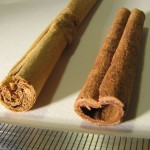
Cinnamon bark scrolls: True cinnamon (left); Cassia (right)
By Catherine Haug, December 10, 2015 (photo, right, from Wikimedia Commons)
Back in 2006 when I went to Sweden and Norway, airports were checking baggage for things that could be a bomb or other destructive device. All travelers were required to use only small containers of personal care items like hand-soap, toothpaste, shampoo, mouthwash, etc., and to put them together in a small plastic bag. My tube of Tom’s of Maine toothpaste was too big, as were other items. What to do?
I decided to make my own toothpowder, but other than using baking soda (which is what my Dad had used), I had no idea what to combine. I ended up buying a tiny bottle of Eco-Dent tooth powder for the trip. I love using a powder – I find it does a better job than toothpaste. If only I had known of the recipe below, I could have made my own.
Homemade tooth powder
The original recipe below is from Learning Herbs website (1); I have added some additional ingredients you may wish to add as well.
One of the original ingredients is myrrh – we hear a lot about that herb during the Christmas season (“gold, frankincense and myrrh”), but just what is it? According to Learning Herbs, it “is a tree resin, and there are historic records saying that folks used it 2000 years ago as they do today…for mouth and gum health.” (1)
About the ingredients (links go to my personal website, Cats Kitchen):
- Myrrh is an aromatic gum resin from a of a number of small, thorny tree species of the genus Commiphora native to Africa. it has antiseptic properties, and is also analgesic if you have a toothache. (3)
- Cinnamon is a common spice in every kitchen and has many health benefits as well as being good for the teeth and gums. Its antimicrobial and astringent ability is important in tooth and gum care; it also adds flavor. Most commercial cinnamon is actually a closely-related herb called cassia. Both have most health benefits in common; cassia has a stronger fragrance/flavor while true cinnamon can lower blood sugar.
- Clove is another common spice in every kitchen; in this recipe it is used for flavor and its antimicrobial properties.
- Licorice root is a non-sugar sweetener that has amazing flavor and health benefits – including antimicrobial ability. However, a word of caution: although it can raise your blood pressure, the small amount in this recipe is not likely to cause adverse effect.
- Stevia is a very sweet herb. You can use finely ground, dried stevia leaf, but to preserve the pleasant color of the spice mix, I recommend using the white stevia extract powder. It takes very little of the white extract powder to sweeten the mix. if using ground leaves, you will need more (I have not experimented with that in a tooth powder so don’t know how much to recommend).
- Xylitol is a sugar alcohol present in birch tree sap, but most commercial xylitol is made from harvested birch wood or corn cobs. It has been shown to reduce tooth decay.
Recipe:
- 2 Tbsp cinnamon powder
- 1 Tbsp myrrh powder
- 2 tsp licorice root powder
- Other suggestions:
- 2 Tbsp baking soda (for alkaline-balancing minerals)
- 2 – 3 tsp finely ground salt (not iodized, unrefined sea salt is ideal but is hard to find in a fine-grind)
- 1 – 2 tsp clove powder
- 2 – 4 Tbsp powdered bentonite clay (provides minerals to re-mineralize teeth, and helps to detox your saliva). See note below.
- tiny pinch stevia powder (as substitute for licorice root if you don’t like licorice)
- 1 tsp xylitol (as substitute for licorice root if you don’t like licorice)
- Equipment:
- glass bowl or jar
- lid for storage jar (use plastic lid if using bentonite clay; see note below)
- wooden spoon or clean wooden stir-stick
Combine ingredients in a glass bowl or jar, blending them together. Store in a small container with a lid.
Important note if using bentonite clay: do not mix or store the powder in a metal bowl or jar, nor use a metal lid. Do not mix with a metal utensil (use a wooden spoon or clean stick). Bentonite clay is negatively charged and if exposed to metal that is positively charged, the reaction will negate the benefits of the bentonite clay. (2)
To use:
- I put a tiny amount (¼ teaspoon or so) in the palm of my hand. Then I wet the bristles of my toothbrush and stir the bristles in the powder so that it sticks to them. If you use baking soda in the powder, it will bubble a bit.
- Alternately, wet your toothbrush bristles; using your fingertips, transfer a tiny amount of the powder to the wet bristles, then brush your teeth. If you wish, you can hold the moist brush over the container of powder to catch any falling powder, but take care not to get drops of water into the powder. (1)
- Then brush teeth and gums as always.
References:
- learningherbs.com/newsletter/homemade-tooth-powder Copyright © 2015 LearningHerbs.
- thehippyhomemaker.com/homemade-herbal-tooth-powder
- Wikipedia: en.wikipedia.org/wiki/Myrrh